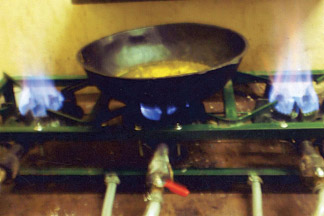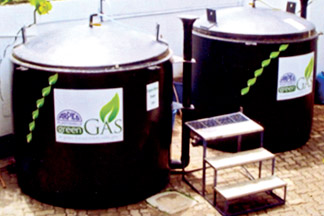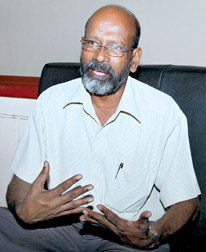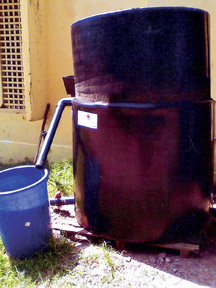|
Call to convert waste into an asset:
Bio-gas for cooking is environment-friendly, less
expensive:
Shot in the arm for bio-gas project
By Ananda Kannangara

Cooking meals using bio-gas at the Ragama Medical Faculty
Fertiliser from a bio-gas unit to plant vegetables.

Two bio-gas units Pix: Saliya Rupasinghe

Fertiliser from a bio-gas unit to plant vegetables. |

Srimal Tissera

First bio-gas plant installed at the SLBC premises. |
People used firewood, charcoal, fossil fuels or electricity for
cooking purposes until the latter part of the last century. Eventually
they replaced them with LP gas.
Gas is a by-product of crude oil. According to current statistics 75
percent of the people worldwide use gas for cooking, burning and heating
purposes.
Sri Lanka's main Liquefied Petroleum Gas (LPG) producer, the Ceylon
Petroleum Corporation (CPC) says that the company produces only 10
percent of the country's internal demand and as a result the country
depends on imported LPG to bridge the gap between the demand and the
limited production.
The Central Bank annual report says that Sri Lankans used 195, 000
metric tonnes of LP gas in 2011 and predicted that 250,000 metric tonnes
of LP gas would be needed in 2013.
Records also indicate that 90 percent of the people in the country
use LP gas for cooking and only 10 percent are using electricity, as we
know, electricity is more expensive than LP gas.
The reality is, the cost of LP gas too is increasing gradually. As a
result the time has come for us to go for an alternative instead of
using LP gas, electricity or even firewood. Using firewood means
destroying valuable forests. Forest destruction will affect the
rainfall.
The country maintains its green environment to the maximum and this
situation helps us to produce our own cooking gas by using our own raw
material. The question is how many of us would toil at least to
experiment whether we could produce gas with the available raw material.
The Sunday Observer last week visited several places in the city and
suburban areas to view the process of manufacturing gas by housewives.
The same gas is also used by hospitals, banks, hotels, restaurants,
factories and universities. This particular gas is not manufactured from
crude oil but is manufactured completely by using local raw material.
Generally, when a person manufactures something, he should pay for
the raw material, but the raw material used to produce this gas is
available free.
One will be interested to know what this freely available raw
material is. It is found everywhere, in your kitchen, in the garden, on
the roads, highways, at market premises or in the hotel bins. The raw
material is none other than waste, such as fruit waste, vegetable waste,
kitchen, market or bakery waste, or any other organic matter that people
throw away.
In addition, used tea leaves, old bakery products, grass cuttings
from the garden, spoilt grain, fruits that are not suitable for human
consumption, spoilt poonac, seeds that are not edible, papers in pulp
form, salvinia plants, water hyacinth (Japan jabara) and all other
organic waste.
Our visit to the Faculty of Medicine in Ragama to watch the process
of manufacturing gas from waste is truly unforgettable. It is surprising
to see how people convert waste into a better purpose.
I remembered the sentence " Waste is an asset to us" written in large
English letters near the Kandy Railway Station. A little girl asked her
father how waste can be an asset. The father replied that if waste is
used in a proper way as in many other countries it could produce gas and
fertiliser.
As we are aware waste when rotten pollutes the environment and causes
various diseases, mosquito breeding grounds and release an unbearable
stench. Therefore, if one takes an interest to produce gas and
fertiliser from waste, he could easily help create a green environment.
Although we have heard about the method of producing gas from waste,
it was the first time that we saw how food is cooked from gas, produced
by waste.
The Dean of the Medical Faculty, Ragama, Rajitha Wickramasinghe
explained to us everything about the newly installed Bio-gas unit and
the importance of having such a unit even in homes or hotels. He
introduced the inventor of this environmentally friendly green gas unit,
Srimal Tissera.
|

Bio-gas unit installed at the Ragama Medical Faculty. |
A product of Thurstan College, Colombo, Srimal has won the
certificate of merit in the field of 'Public Welfare' at the
Presidential Awards of 2010 for his invention of the compact bio-gas
plant.
The bio-gas plant has an artificial stomach, similar to a human
stomach. The plant contains a pipe fixed by the side of the unit which
acts as a feeder where the waste is fed into the tank. The waste then
travels to the top tank where it is digested. After the waste is
digested, it travels down to the centre of the tank and starts to get
fermented, and gas is formed. There is an outlet in the unit for gas to
be obtained.
When interviewed, Tissera said most bio-gas plants in Sri Lanka are
designed for cow-dung and other animal manure as the main feedstock and
they are used in rural areas. The majority of the people in urban areas
use LP gas , kerosene or electricity for cooking. Therefore, it is an
advantage to own a compact bio-gas system in homes or hotels as it would
help save the daily expenditure to a great extent.
Using bio-gas to cook the daily meals is an environmentally friendly
cooking system for housewives. bio-gas could be used not only for
cooking, but also for lighting lamps in the same manner as petromax
lamps and also to operate crematoriums.
When we visited the Ayurvedic Research Institute at Navinna to view a
bio-gas plant, a senior official of the institute explained how they
were able to reduce 50 percent of the cost spent on cooking meals for
the labour force.
Tissera said his bio-gas units are currently used in over 100
Government and private institutions in the country, including the
Faculty of Science, Colombo University, Southern Development Authority,
BMICH, Colombo, Maliban Biscuits Ltd, Serendib Hotels and the CEB
Training Centre, in Kalutara.
Tissera said he had brought his invention to the notice of several
senior officials of the Environment Ministry, the Central Environmental
Authority and the Sustainable Energy Authority, but nobody has paid any
attention to give him a helping hand to develop the industry.
He said he visited several countries including India, Vietnam and
Thailand to view bio-gas projects and said that the structure may be
similar, but the technology is totally different.
Tissera said this newspaper article would help all countrymen
including responsible Government officials who love a pollution free
environment to expand the bio-gas projects in Sri Lanka.
(Srimal Tissera could be contacted on email:
[email protected]) |



